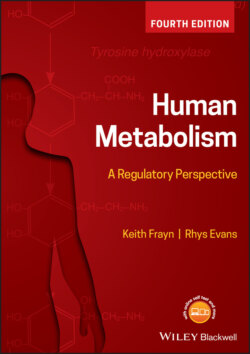Читать книгу Human Metabolism - Keith N. Frayn - Страница 45
1.3.3.4 Fatty acid synthesis
ОглавлениеThe body may acquire fatty acids either from dietary fats, or it may synthesise them de novo from dietary non-lipid sources (lipogenesis). Acetyl-CoA derived from excess carbohydrates and amino acids surplus to current energy requirements is assembled into long chain fatty acids in the cytosol of lipogenic tissues such as liver and adipose tissue (and then esterified to form triacylglycerol) for energy storage. The initiating (first committed) step involves generation of malonyl-CoA (the first committed intermediate of lipogenesis, and unique to this pathway) from acetyl-CoA and bicarbonate (HCO3−) by acetyl-CoA carboxylase, and is highly regulated. The malonyl group is the donor for fatty acid synthase, a multi-catalytic polypeptide which elongates the growing fatty acid chain by 2 carbons in a repeated cycle using NADPH for energy. The fatty acid chain formed can undergo several modifications, including desaturation. The commonest fatty acids in human metabolism are palmitic (16 carbons, saturated) and oleic (18 carbons, one unsaturated bond). (This is explored further in Chapter 5, see Box 5.4.) Lipogenesis is the opposite pathway to β-oxidation, but although the chemical processes are opposite (β-oxidation: hydration, oxidation; lipogenesis: dehydration, reduction), the pathways do not utilise the same enzymes. Furthermore, lipogenesis occurs in the cytosol, whilst β-oxidation occurs in the mitochondrion, an example of intracellular compartmentation preventing substrate (futile) cycling of two opposing pathways.
The mature fatty acid is activated with CoA, forming fatty acyl-CoA, the starting point for further metabolism, by ACS (one of a family of enzymes acting on different chain length fatty acids). The primary end-point of mammalian fatty acid synthesis is palmitic acid (see Box 1.3), a 16-carbon saturated fatty acid (16:0 using the nomenclature of Box 1.3). For most cellular functions, a wide range of fatty acids is required (e.g. phospholipids formed entirely of saturated fatty acids would form very rigid membranes). Lipogenic tissues therefore also express elongase enzymes (there is a family of these: they use acetyl-CoA to add 2 carbons at a time to the carboxyl end of a fatty acid), and desaturases, which can remove hydrogen to form double-bonds. Thus, for instance, palmitic acid (16:0) can be converted to palmitoleic acid (16:1 n-7), stearic acid (18:0) and oleic acid (18:1 n-9). More details will be given later (Box 5.4).
Although the pathway of de novo lipogenesis, primarily the synthesis of fatty acids from glucose, is expressed and undoubtedly operates in human cells (adipocytes and liver; Chapter 5), it contributes only a small proportion of the fat stored in adipose tissue under most conditions – this will be discussed further in Chapter 7 (Box 7.2).
